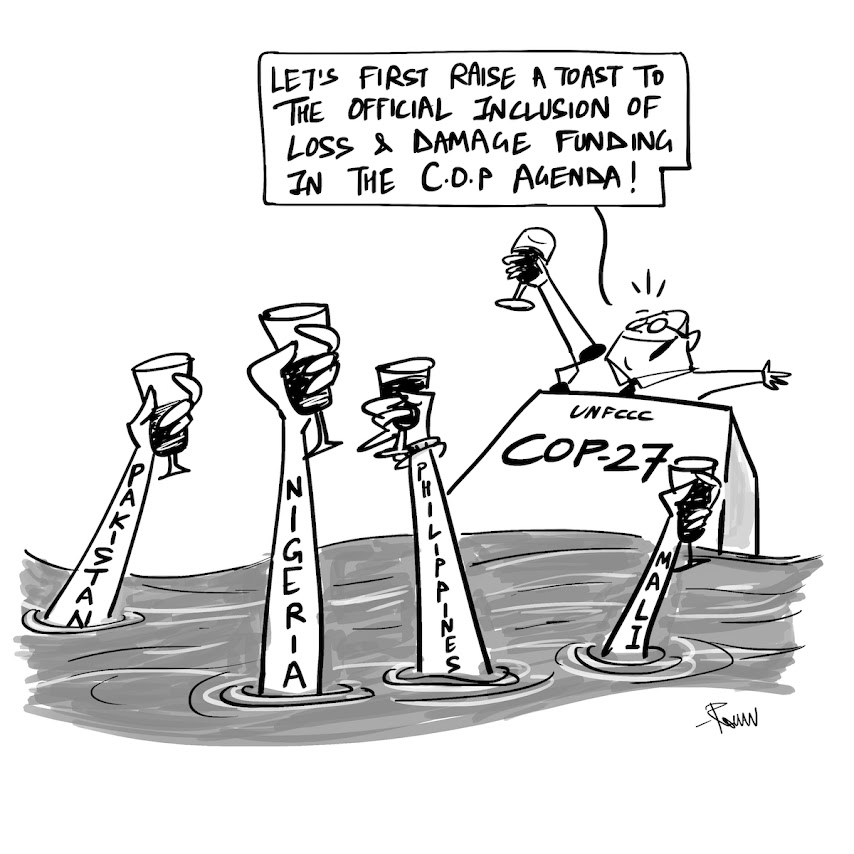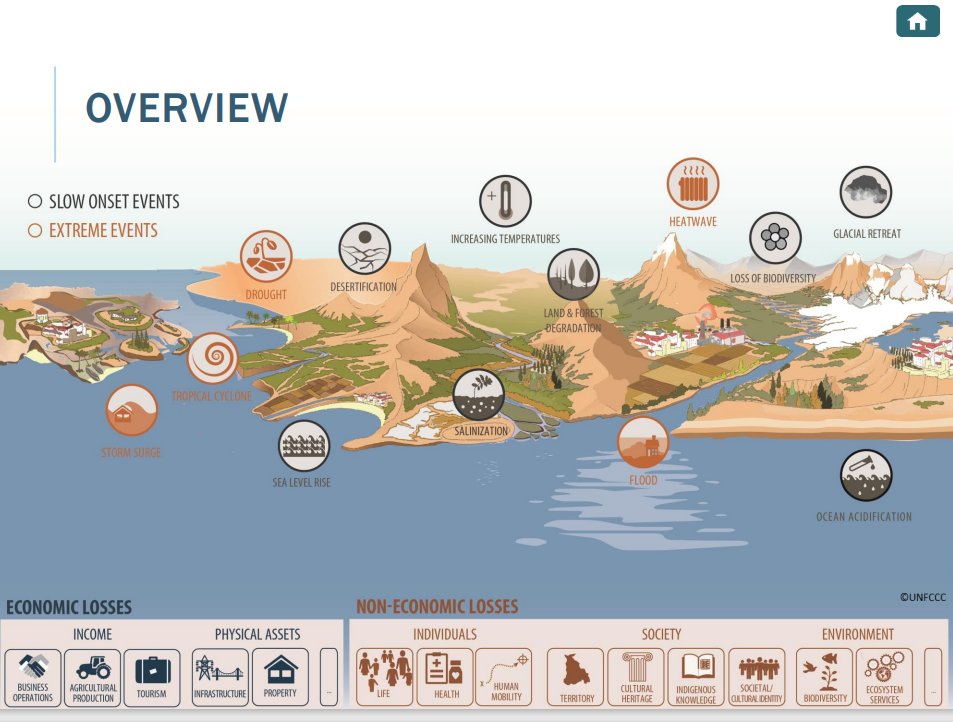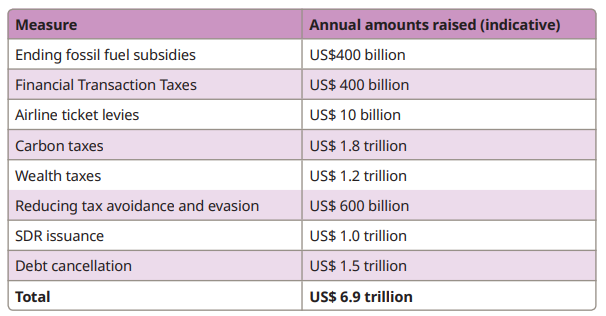We can already draw on the experience from WASH L&D trailblazers Vanuatu and Bangladesh.
Published on: 14/12/2022

Credit: Rohan Chakravarty, Live Cartoons at COP27, 8 Nov 2022
Rural Bangladesh households spend almost US$ 2 billion on repairing the damage caused by climate change and on prevention measures. This is two times the amount that government spends, and 12 times more than international donors.
Arguably, the only positive outcome of COP27, the 2022 UN Climate Change Conference in Sharm El-Sheikh, was an agreement to provide “Loss and Damage” (L&D) funding for vulnerable countries hit hard by climate disasters. This funding would be additional to existing commitments for climate mitigation, climate adaptation and climate-related humanitarian aid. The agreement was 30 years in the making. It finally succeeded thanks to the strong lobby by the G77 coalition of 134 developing countries and China.
The L&D fund did come at a price, which could undermine its very success: there was no agreement to phase out, or at least phase down, all fossil fuels. As Joab Okanda, senior Africa adviser for Christian Aid, remarked: “more fossil fuels means more loss and damage.”
The UNFCCC Santiago Network will provide technical assistance on L&D to developing countries. A transitional committee will present recommendations on how to operationalise both the new funding arrangements and the fund at COP28, which is being held in Dubai from 30 November to 12 December 2023.
L&D refers to harm and destruction – both economic and non economic - caused by climate change impacts that cannot be avoided through mitigation or adaptation. Impacts of climate change include slow onset events and extreme weather events which may both result in L&D - see the overview below.

Credit: Warsaw International Mechanism for Loss and Damage associated with Climate Change Impacts (WIM), UNFCCC. Loss and Damage online guide
Repair or reconstruction of water, sanitation and hygiene (WASH) infrastructure damaged by extreme weather events is an obvious contender for L&D financing. The same applies for lost income suffered by WASH service providers and the businesses that rely on them. Water resource-related L&D caused by slow onset events such as salinisation of groundwater linked to sea level rise, drought and land and forest degradation could also be eligible for funding. Compensation could be sought for the extra costs of water treatment, water source protection or switching to new water sources.
Compensation for health-related L&D caused by outbreaks of water-borne diseases and diseases caused by drinking saline water, could be spent on water treatment or alternative sources of safe drinking water.
Ideally any L&D investments in the WASH sector should be supplemented by WASH adaptation funding. This would help ensure that restored services are climate resilient.
There is a great deal of uncertainty about the scale of projected L&D from climate change. Different models (tab. 1, p. 6) predict 1.5-10% loss of GDP by 2050, US$ 190 trillion of non-economic damages to ecosystems by 2050 and US$ 2-4 billion increase of annual healthcare costs and 250,000 excess deaths per year between 2030 and 2050.
The Vulnerable Twenty (V20) Group estimated that its 58 member countries lost approximately US$ 525 billion over the last two decades because of climate change. This represents about one fifth of their wealth.
The Pacific island country Vanuatu (pop. 308,000) is one of the first to cover L&D in its Nationally Determined Contribution (NDC) report. In 2020 Cyclone Harold caused damages estimated at US$ 600M (more than 60% of GDP) while billions more have been lost over the last decade from slow onset impacts such as ocean acidification and sea level rise. The cost of achieving Vanuatu’s NDC conditional L&D targets for 2021-2030 are US$ 177.67M compared to US$ 721.08M for adaptation (of which US$ 125M for water).
So far Denmark, New Zealand, Belgium, Germany, Austria, Ireland, and Canada plus the sub-national governments Wallonia and Scotland have pledged around US$ 300M for L&D. Not all is new money and 2/3 is going to the Global Shield against Climate Risks, a G7 / V20 insurance partnership. The Scottish government has collaborated with the Climate Justice Resilience Fund (CJRF) to fund small-scale L&D projects. For a good overview on funding for L&D see this graphic by Prof. Saleemul Huq and Mimansha Joshi.
The funding pledged so far is nowhere near the amount needed to cover the projected L&D from climate change. Those rich countries and industries that are overwhelmingly responsible for climate change need to pay their fair share towards the new UNFCCC L&D fund, which will be operationalised at COP28. Next to raising enough money, the L&D fund will need to employ less onerous terms than those of existing climate funds, such as the Green Climate Fund (GCF), to ensure timely payment for those most in need.
In a companion IRC blog, Dr. Kurian Baby proposes that taxation of global commons could achieve and sustain the scale of L&D financing needed. End Water Poverty and WaterAid complement these types of taxes with other sources in the table below from their 2021 WASH financing "Blueprint” report. Since their report, initiatives promoting debt cancellation or debt swaps for climate finance have gained traction. Another development that could support L&D funding is the increase in climate litigation aimed at governments and the fossil fuel industry. In this regard, a coalition of 17 countries led by Vanuatu have drafted a UN resolution requesting an advisory opinion from the International Court of Justice (ICJ) on states’ legal obligation for climate action and the consequences of causing harm.

Potential sources of funding required to achieve SDG and climate goals by 2030. Credit: End Water Poverty / WaterAid, 2021. Blueprint: financing a future of safe water, sanitation and hygiene for all [SDR = Special Drawing Rights]
WaterAid Bangladesh is currently working to understand the economic and non-economic impacts of disasters and hazards on WASH. The 2021 Mission-critical report estimated that every dollar invested in strategic flood resilience upgrades could avoid up to US$ 96 in flood restoration costs. It estimated the total cost of damage and recovery came to around US$ 476 million whereas the cost of building flood resilient WASH infrastructures would cost around US$ 90 million. WaterAid’s study also showed the loss of WASH benefits. WASH services in Bangladesh provide an annual benefit of US$ 28 per person for basic water services and US$ 49 per person for basic sanitation services. As a result of the service disruptions, the 2020 floods cost Bangladesh at least US $217 million in reduced WASH service benefits. Another US$ 258 million was needed for post-disaster recovery.
To understand the extent of L&D specifically for WASH (economic) and migration (non-economic), WaterAid Bangladesh and the National Disaster Response Coordination Center (NDRCC) are collaborating to unlock the impacts from a water lens. A rough estimation of the L&D deduced from the national Forms for Assessment of Damage and Loss (Form-D) alongside WaterAid’s own database was presented at COP27.
L&D funds will not be available immediately. In the meantime, the poorest and least responsible for climate change are still paying the most to repair the damage.
National WASH strategies and plans need to start including L&D, taking into account economic and non-economic impacts. The extra funding required for WASH L&D should be incorporated in Nationally Determined Contribution (NDC) reporting. We can already draw on the experience from WASH L&D trailblazers Vanuatu and Bangladesh.
Finally the corporate-sponsored WASH development sector should be braver by actively supporting initiatives that strive to end fossil fuel addiction. As Christian Aid’s Joab Okanda said: “more fossil fuels means more loss and damage”.
Acknowledgements: Adnan I. A. Qader, Senior Advocacy Officer – Water and Climate, WaterAid Bangladesh provided the text of the Bangladesh case study.
At IRC we have strong opinions and we value honest and frank discussion, so you won't be surprised to hear that not all the opinions on this site represent our official policy.